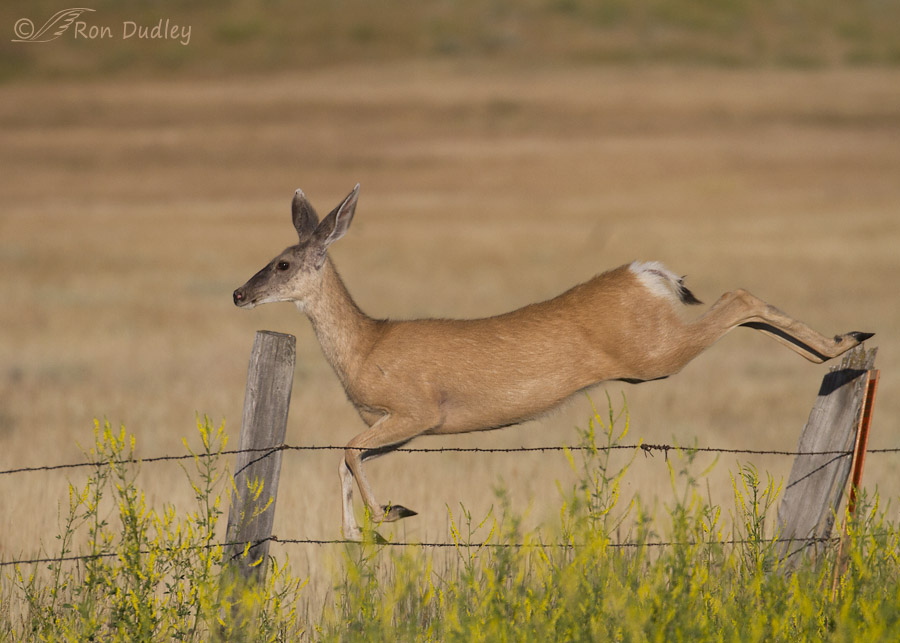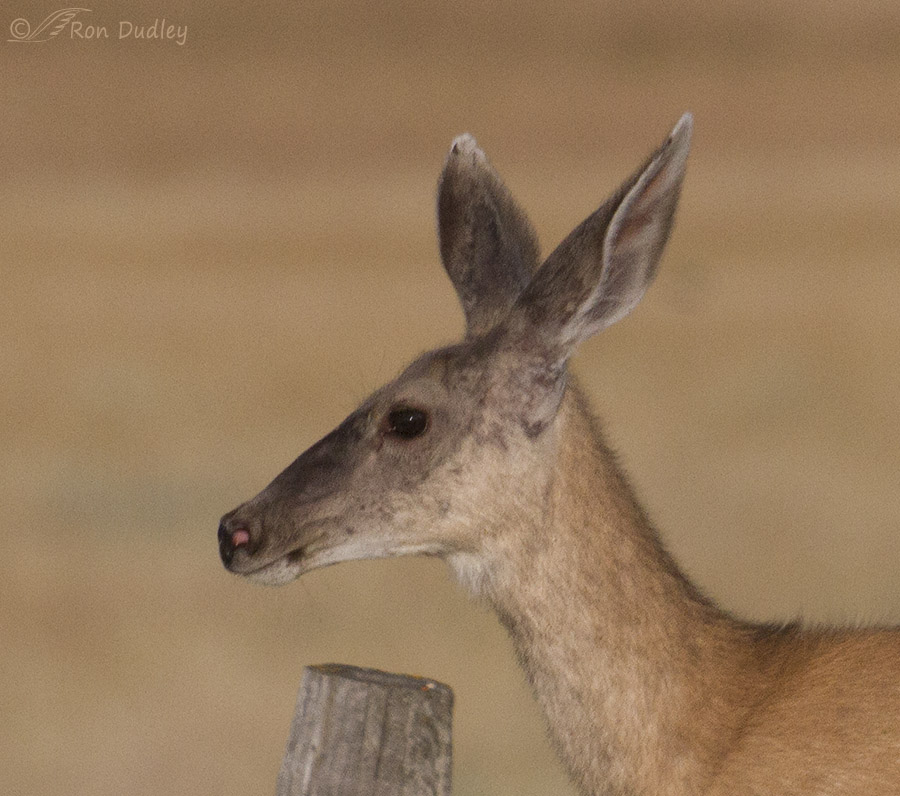Fences are a problem for wildlife in Montana’s Centennial Valley. The 27 mile long main access road that runs the length of the valley is lined closely on both sides by fences that are a mishmash of types and conditions and most of them are not “wildlife friendly”. It’s common for deer and pronghorn to breach one of the fences and graze the more lush vegetation along the gravel road that hasn’t already been chomped down by cattle. When that happens and a vehicle comes along the animal typically feels menaced and trapped by that noisy, dusty contraption and panics as it tries to cross the fence and escape to safety.
The fences are especially problematic for pronghorn because they typically can’t jump the fences so they have to find a break in the lower wire or a place where that wire is high enough off the ground that they can duck underneath it but deer can have a difficult time with the fences too. About three weeks ago in the early morning I encountered this deer along the road and because of somewhat unusual circumstances it had difficulty finding a place where it could jump the fence.

1/3200, f/7.1, ISO 500, Canon 7D Mark II, Canon EF100-400mm f/4.5-5.6L IS II USM @ 400mm, not baited, set up or called in
In this area there was a very steep slope directly in front of the fence that made jumping it from this side almost impossible. As I approached in my pickup this animal and several others obviously felt trapped so I simply stopped on the road and gave them time to find a spot in the fence they could negotiate. It took them a while but eventually they settled on this spot but even then the only way they could jump it was to stand right next to the fence where they were at the top of the slope and jump it almost lengthwise – thus this unusual angle of the deer in the air to the fence. If I had continued along the road at my usual speed of 30 mph they may have felt panicked enough that they’d have been forced to jump at a more dangerous spot and one or more of them could have become entangled in the fence.
From a conversation I had on this trip with an employee of nearby Red Rock Lakes National Wildlife Refuge I know that local ranchers are feeling some pressure to make their fences more wildlife friendly but fences are an expensive proposition and I suspect that any improvements will take some time. I hope it happens sooner rather than later.
Based largely on its tail (white above, tipped with black) I can only conclude that the animal in this photo is a Mule Deer (White-tailed Deer are more common in the valley) but several of its features sure look strange to me. I don’t pretend to know a lot about deer but the almost black face and ears seem to me to be out-of-place to say the least.

A huge crop of the previous image gives us a better look at the head. I simply can’t reconcile this black coloration with any other Mule Deer (or any other deer species for that matter) I’ve ever seen. I had photos of the other deer with this animal as they jumped the fence but they were soft so sadly I deleted them before I noticed anything unusual about this one.
I’d appreciate feedback about this animal from any readers who may know more about deer than I do. Is this one atypical or is this coloration within the normal range of variation within the species?
Ron


This individual is very dark in the face, but the Arizona Sonoran Desert mulies were dark in the face during 1970-1972 when I pursued my MS in wildlife and fisheries ecology.
In 1970 – 1972 in the ASU wildlife ecology MS track, the Sonoran Desert mule deer appeared dark in the face – if you could get close enough to see it.
I sent you a message on Facebook (your “others” box), and it has a photo attached that has a “dark” face. More splotched than dark, but thought you might find it interesting.
Though I don’t comment much, I start my day with your blog post. Thanks for all the work you put into this site.
could it be a white-tail in blackface???
Fencing expense seems to be a world-wide issue. One of my first memories about a country drive with my family was my father commenting ‘that farm is obviously doing well – look at the fences…’
Love that you allowed the deer time to take the fence safely.
Yes, EC, I think the condition of a fence is a often a good indicator of how well the farmer or rancher is doing financially. One of my Montana cousins recently completed fencing their entire place and it was very expensive and labor intensive.
I believe Doug is right. Looking at the first picture you can see black on top of the tail, and if you check pictures of Black-tailed Deer on the internet their face/muzzle look very similar to Ron’s deer image.
Dick, I’m not seeing the black head and ears in the images of black-tails when I do an image search…??? A dark patch on the upper forehead of some of them is all I’m seeing. And the tail of a black-tail is “black or brown on top”. The only black I’m seeing on the tail in my first photo is on the tip, not the top.
It may be a Black-tail doe.
Doug, as far as I know Black-tails (a mule deer sub-species) still don’t typically have the black face and ears.
Definitely unusual coloration. The other possibility that occurs to me is genetic mutation – which I think about after having encountered piebald deer this summer.
As a biologist that possibility also occurred to me, Susan.
It looks as if there is a scar behind the ear, and the hair on the face, ears and neck look thin. Perhaps damage from a wildfire?
Carolyn, there were no fires in that area and hadn’t been all summer as far as I know.
Sorry to double post. It might be a hybrid. http://agrilife.org/texnatwildlife/deer/managing-desert-mule-deerb-1636/white-tailed-vs-mule-deer/
I suppose that’s possible but when the article describes what a hybrid white-tail x mulie looks like there’s no mention of the almost black face and ears.
From the close up, it almost looks as if there is significant hair loss around the face. I wonder if the coloring is from some type of skin damage? But with those ears, it’s got to be a mule deer.
I wondered about that too, Arwen I just don’t know…
Great shots as usual and interesting note.
I would agree, this fellow does look quite different. White-tailed Deer have a whitish band just behind the nose and darker to the head, whereas Mule Deer have a much wider lighter mass on front of their muzzle. This fellow has neither. Consequently, your guess is as good as mine. it will be interesting to read what the experts on this blog have to say.
Thanks for letting me know that you also think it looks “different”, Dick. I was afraid I was going to be embarrassed for thinking it’s different when it’s actually typical – I really don’t know deer very well.